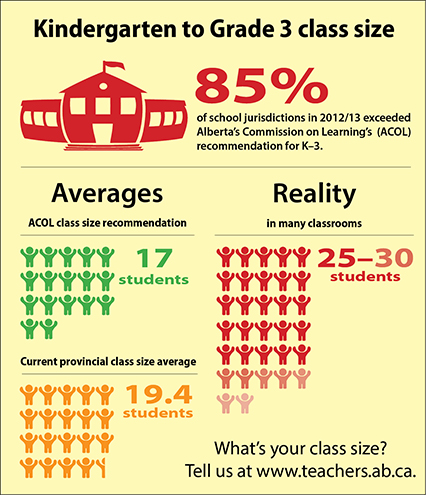Page Content
“What we’ll get in the end is more official accounting that makes classes seem much smaller than parents know they are.”
—Don Braid, Calgary Herald, October 8, 2003
That quote from Don Braid was taken from his 2003 column responding to the report from Alberta’s Commission on Learning (ACOL) that had just been released by Alberta Learning (now Alberta Education).
And, can you hear that? It’s his words ringing true, exactly 10 years to the date.
The ACOL report recommended implementation of the following guidelines for average class sizes:
- Junior kindergarten–Grade 3: 17 students
- Grades 4–6: 23 students
- Grades 7–9: 25 students
- Grades 10–12: 27 students
Enrolment numbers and class sizes for this school year have yet to be released, but statistics for 2012/13 show that out of 62 school jurisdictions
- 53 (85 per cent) exceeded class size guidelines for K–3 (10 per cent increase over 2011/12),
- 16 exceeded class size guidelines for Grades 4–6 (31 per cent increase over 2011/12),
- 4 exceeded class size guidelines for Grades 7–9 (75 per cent increase over 2011/12) and
- 0 exceeded class size guidelines for Grades 10–12 (same as 2011/12).

Not all jurisdictions make school-by-school class size reports available on their websites, but some do. A scan of available reports reveals that the class size averages don’t reflect anything close to the reality in many schools across the province.
Schools across the province—not just in Calgary and Edmonton but also in centres such as Banff, Red Deer, Ponoka and Eckville—have K–3 classrooms with more than 20 students. Edmonton Public Schools reported 47 per cent of its K–3 classrooms having 21–25 students and 13 per cent having 26–30 students.
Many Grades 4–6 classrooms bubble over the ACOL guidelines in jurisdictions such as Red Deer Catholic Regional Division, Rocky View School Division (RVSD) and St. Thomas Aquinas Roman Catholic Schools. St. Albert Public School District reported that 16 per cent of its classrooms at that level have 26–30 students. Schools in RVSD are also squeezed at the junior high level, with many classrooms above 27 students and a couple at 30 students.
As for high schools, especially in Calgary and Edmonton, a number of jurisdictions are feeling a pinch that can’t be seen when looking solely at class size averages. The perfect example is Edmonton Public Schools, which reported a jurisdiction class size average of 26.1 students but also that more than one-quarter of its classes had 31–35 students and 9 per cent had 36–40 students.
“The Alberta government and its ministry of education need to realize average is not reality,” said ATA President Mark Ramsankar. “They need to start addressing the issue of class size in a realistic manner, looking at the numbers of real students in real classrooms and providing school boards with the funding to deal with those circumstances.”
The ATA president can’t see how class size averages are congruent with the government’s vision for education. “The government’s Inspiring Education initiative is focused on student-centred education,” he said. “But by looking at something as critical as class size in terms of averages, the government seems unconcerned that thousands of Alberta students go to school in overcrowded classrooms and are saddled with untenable learning conditions.” ❚
